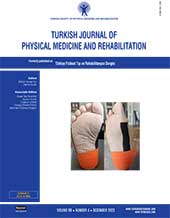Applying the WHO ICF framework to long COVID patients with persistent respiratory symptoms
2 Department of Physical Medicine and Rehabilitation, Ankara University Faculty of Medicine, Ankara, Türkiye
3 Department of Physical Medicine and Rehabilitation, University of Health Sciences, Ankara City Health Training and Research Center, Ankara, Türkiye
4 Department of Physical Medicine and Rehabilitation, Eskişehir City Hospital, Eskişehir, Türkiye
5 Department of Physical Medicine and Rehabilitation, University of Health Sciences, Istanbul Physical Medicine and Rehabilitation Training and Research Hospital, Istanbul, Türkiye
6 Department of Physical Medicine and Rehabilitation, Turkish Ministry of Health, Erenköy Physical Therapy and Rehabilitation Hospital, Istanbul, Türkiye
7 Department of Physical Medicine and Rehabilitation, Ahi Evran University Faculty of Medicine, Kırşehir, Türkiye
8 Department of Physical Medicine and Rehabilitation, Pamukkale University Faculty of Medicine, Denizli, Türkiye
9 Department of Physical Medicine and Rehabilitation, University of Health Sciences, Hamidiye Faculty of Medicine, Antalya Health Reserch Center, Antalya, Türkiye
10 Department of Physical Medicine and Rehabilitation, University of Health Sciences, Kayseri City Health Training and Research Hospital, Kayseri, Türkiye
11 Department of Physical Medicine and Rehabilitation, Zonguldak Bülent Ecevit University School of Medicine, Zonguldak, Türkiye
12 Department of Physical Medicine and Rehabilitation, Manisa Celal Bayar University Faculty of Medicine, Manisa, Türkiye
13 Department of Physical Medicine and Rehabilitation, Trakya University Faculty of Medicine, Edirne, Türkiye
14 Department of Physical Medicine and Rehabilitation, University of Health Sciences, Gaziler Physical Therapy and Rehabilitation Training and Research Hospital, Ankara, Türkiye
15 Department of Biostatistics, Ankara Yıldırım Beyazıt University Medical School, Ankara, Türkiye DOI : 10.5606/tftrd.2023.13455 Objectives: The aim of this study was to evaluate long COVID patients with persistent respiratory symptoms through the application of the World Health Organization (WHO) International Classification of Functioning, Disability and Health (ICF) framework.
Patients and methods: This national, prospective, multicenter, cross-sectional study was conducted with 213 patients (118 females, 95 males; median age 56 years; range, 20 to 85 years) with long COVID between February 2022 and November 2022. The ICF data were primarily collected through patient interviews and from the acute medical management records, physical examination findings, rehabilitation outcomes, and laboratory test results. Each parameter was linked to the Component Body Functions (CBF), the Component Body Structures (CBS), the Component Activities and Participation (CAP), the Component Environmental Factors (CEF), and Personal Factors according to the ICF linking rules. Analysis was made of the frequency of the problems encountered at each level of ICF category and by what percentage of the patient sample.
Results: In the ICF, 21 categories for CBF, 1 category for CBS, and 18 categories of CAP were reported as a significant problem in a Turkish population of long COVID patients with persistent respiratory symptoms. Furthermore, eight categories for CEF were described as a facilitator, and four as a barrier.
Conclusion: These results can be of guidance and provide insight into the identification of health and health-related conditions of long COVID patients with persistent respiratory symptoms beyond the pathophysiological aspects, organ involvement, and damage of COVID-19. The ICF can be used in patients with long COVID to describe the types and magnitude of impairments, restrictions, special needs, and complications.
Keywords : Long COVID, International Classification of Functioning, respiratory problems

















